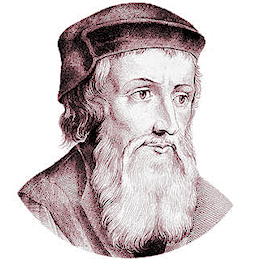Textus Receptus Bibles
John Wycliffe Bible 1382
| 10:1 | And Y siy, and lo! in the firmament that was on the heed of cherubyns, as a saphir stoon, and as the fourme of licnesse of a kyngis seete apperide theron. |
| 10:2 | And he seide to the man that was clothid in lynnun clothis, and spak, Entre thou in the myddis of wheelis, that ben vndur cherubyns, and fille thin hond with coolis of fier, that ben bitwixe cherubyns, and schede thou out on the citee. |
| 10:3 | And he entride in my siyt; forsothe cherubyns stoden at the riyt side of the hous, whanne the man entride, and a clowde fillide the ynnere halle. |
| 10:4 | And the glorie of the Lord was reisid fro aboue cherubyns to the threisfold of the hous; and the hous was fillid with a cloude, and the halle was fillid with schynyng of the glorie of the Lord. |
| 10:5 | And the sown of wyngis of cherubyns was herd til to the outermere halle, as the vois of almyyti God spekynge. |
| 10:6 | And whanne he hadde comaundid to the man that was clothid in lynnun clothis, and hadde seid, Take thou fier fro the myddis of the wheelis, that ben bitwixe cherubyns, he entride, and stood bisidis the wheel. |
| 10:7 | And cherub stretchide forth his hond fro the myddis of cherubyns, to the fier that was bitwixe cherubyns; and took, and yaf in to the hondis of hym that was clothid in lynnun clothis; and he took, and yede out. |
| 10:8 | And the licnesse of the hond of a man apperide in cherubyns, vndur the wyngis of tho. |
| 10:9 | And Y siy, and lo! foure wheelis weren bisidis cherubyns; o wheel bisidis o cherub, and another wheel bisidis another cherub; forsothe the licnesse of wheelis was as the siyt of the stoon crisolitis. |
| 10:10 | And the biholdyng of tho was o licnesse of foure, as if a wheel be in the myddis of a wheel. |
| 10:11 | And whanne tho yeden, tho yeden in to foure partis; tho turneden not ayen goynge, but to the place to which that that was the firste wheel bowide to go, also othere suyden, and turneden not ayen. |
| 10:12 | And al the bodi of tho wheelis, and the neckis, and hondis, and wyngis of the beestis, and the cerclis, weren ful of iyen, in the cumpas of foure wheelis. |
| 10:13 | And he clepide tho wheelis volible, ether able to go al aboute, in myn heryng. |
| 10:14 | Forsothe o beeste hadde foure faces; o face was the face of cherub, and the secounde face the face of a man, and in the thridde was the face of a lioun, and in the fourthe was the face of an egle; |
| 10:15 | and the cherubyns weren reisid. Thilke is the beeste, which Y hadde seyn bisidis the flood Chobar. |
| 10:16 | And whanne cherubyns yeden, also the wheelis bisidis tho yeden to gidere; whanne cherubyns reisiden her wyngis, that tho schulden be enhaunsid fro the erthe, the wheelis abididen not stille, but also tho weren bisidis cherubyns. |
| 10:17 | The wheelis stooden with tho cherubyns stondynge, and weren reisid with the cherubyns reisid; for the spirit of lijf was in tho wheelis. |
| 10:18 | And the glorie of the Lord yede out fro the threisfold of the temple, and stood on the cherubyns. |
| 10:19 | And cherubyns reisiden her wyngis, and weren enhaunsid fro the erthe bifore me; and whanne tho yeden out, also the wheelis sueden; and it stood in the entryng of the eest yate of the hous of the Lord, and the glorie of God of Israel was on tho. |
| 10:20 | Thilke is the beeste, which Y siy vndur God of Israel, bisidis the flood Chobar. And Y vndurstood that foure cherubyns weren; |
| 10:21 | foure faces weren to oon, and foure wyngys weren to oon; and the licnesse of the hond of a man was vndur the wyngis of tho. |
| 10:22 | And the licnesse of the cheris of tho weren thilke cheeris whiche Y hadde seyn bisidis the flood Chobar; and the biholdyng of tho, and the fersnesse of ech, was to entre bifor his face. |

John Wycliffe Bible 1382
The Wycliffe Bible is the only Bible here that was not translated from the Textus Receptus. Its inclusion here is for the Bible's historic value and for comparison in the English language.
John Wycliffe, an Oxford professor produced the first hand-written English language Bible manuscripts in the 1380's. While it is doubtful Wycliffe himself translated the versions that bear his name, he certainly can be considered the driving force behind the project. He strongly believed in having the scriptures available to the people.
Wycliffe, was well-known throughout Europe for his opposition to the teaching of the organized Church, which he believed to be contrary to the Bible. With the help of his followers (called Lollards), Wycliffe produced dozens of English language manuscript copies of the scriptures. They were translated out of the Latin Vulgate, which was the only source text available to Wycliffe. The Pope was so infuriated by his teachings and his translation of the Bible into English, that 44 years after Wycliffe died, he ordered the bones to be dug-up, crushed, and scattered in the river.